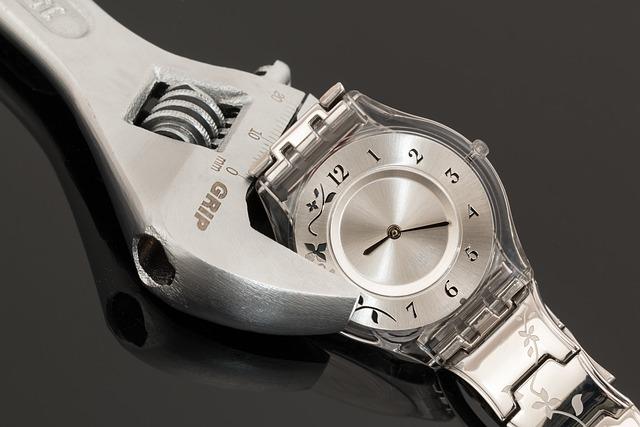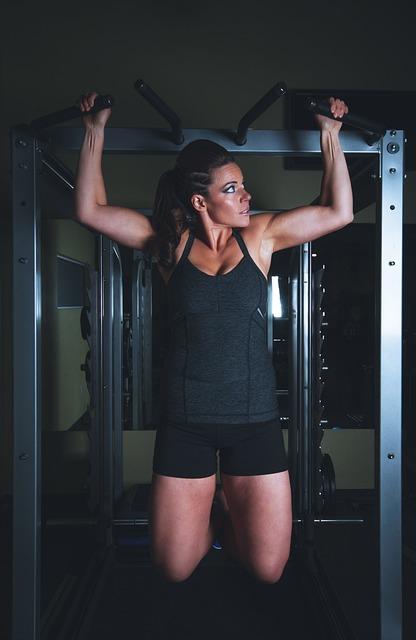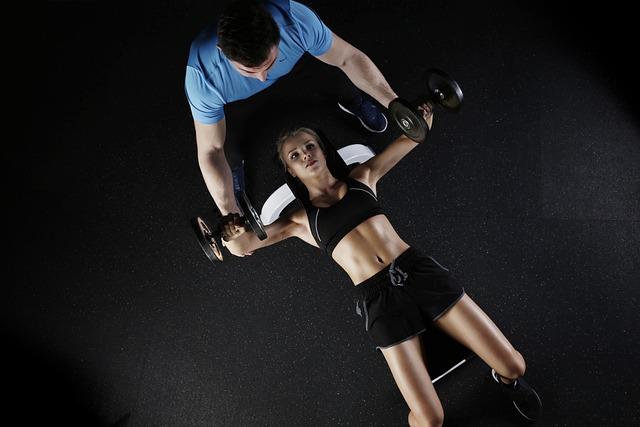Pull Workouts with Dumbbells: Intensify Your Pull Routine!

Are you looking to take your pull routine to the next level? Look no further than pull workouts with dumbbells! By incorporating dumbbells into your workout, you can intensify your pull exercises and achieve impressive results. Whether you’re a beginner or a fitness enthusiast, this article will provide you with valuable insights and expert tips on how to maximize your gains. Get ready to unlock your full potential and transform your physique! Let’s dive into the world of pull workouts with dumbbells and discover how they can revolutionize your fitness journey.
Contents
- 1. Strengthen Your Back and Biceps with Dumbbell Rows and Curls
- 2. Target Multiple Muscles with Compound Movements
- 3. Exploring Advanced Variation: One-Arm Dumbbell Rows and Hammer Curls
- 4. Fine-Tune Your Form for Optimal Results
- 5. Get Creative with Pull Exercises: Renegade Rows and Farmer’s Walks
- 6. Incorporate Dumbbell Pull Overs to Enhance Lat Development
- 7. Effective Pull Workout Strategies: Supersets and Drop Sets
- 8. Build Endurance and Strength with High-Intensity Interval Training (HIIT)
- 9. Achieve Balanced Muscle Development with Rear Delt Exercises
- 10. Maximize Your Pull Workout with Proper Warm-up and Recovery Techniques
1. Strengthen Your Back and Biceps with Dumbbell Rows and Curls
Pull Workouts with Dumbbells: Intensify Your Pull Routine!
Dumbbell rows and curls are two incredibly effective exercises that can help you strengthen your back and biceps, and adding them to your pull workouts can take your routine to the next level. These exercises not only target specific muscle groups but also engage multiple muscles, making them ideal for building overall upper body strength.
Dumbbell rows primarily target your back muscles, specifically the lats, traps, and rhomboids. They also engage your biceps, forearms, and core muscles for stability. To perform dumbbell rows, you’ll need a dumbbell and a bench. Start by placing your left knee and hand on the bench, with your right foot planted on the ground. Hold the dumbbell in your right hand, allowing your arm to hang straight down. Pull the dumbbell up towards your waist, keeping your elbow close to your body and squeezing your back muscles at the top of the movement. Repeat for the desired number of repetitions, then switch sides.
Dumbbell curls, on the other hand, primarily target your biceps, with some engagement of your forearms and shoulders. To perform dumbbell curls, stand with a dumbbell in each hand, palms facing forward. Keep your elbows close to your sides and slowly curl the weights up towards your shoulders, making sure to squeeze your biceps at the top of the movement. Lower the dumbbells back down in a controlled manner and repeat for the desired number of repetitions.
Incorporating dumbbell rows and curls into your pull workouts will not only help develop strength and definition in your back and biceps but also improve your overall upper body strength. Remember to choose a weight that challenges you but still allows you to perform the exercises with proper form. Start with 2-3 sets of 12-15 repetitions and gradually increase the weight and intensity as you get stronger. Give these exercises a try and experience the transformative power they can have on your pull routine!
2. Target Multiple Muscles with Compound Movements
Incorporating compound movements into your pull workouts is a surefire way to take your routine to the next level. Not only do compound exercises target multiple muscles simultaneously, but they also activate stabilizer muscles to improve overall strength and balance. When it comes to pull workouts with dumbbells, these compound movements are a game-changer that will maximize your gains and enhance your physique.
One essential compound movement to include in your pull routine is the dumbbell bent-over row. This exercise targets a wide range of muscles, including your upper back, shoulders, biceps, and core. To perform the bent-over row, stand with your feet shoulder-width apart, holding a dumbbell in each hand with an overhand grip. Hinge at the hips, keeping your back straight, and lower your torso until it is almost parallel to the ground. Pull the dumbbells up towards your upper abdomen, squeezing your shoulder blades together. Slowly lower the weights back down and repeat for the desired number of reps. By incorporating the dumbbell bent-over row into your pull routine, you’ll build a stronger, more defined upper body.
Another compound movement you should consider is the dumbbell pull-over. This exercise engages your lats, triceps, chest, and shoulders, and offers a great stretch to your upper body. To perform the pull-over, lie flat on a bench with your feet planted on the ground and your knees bent. Holding a dumbbell with both hands, extend your arms over your head, keeping a slight bend in your elbows. Lower the weight behind you in an arc motion until you feel a stretch in your chest and lats. Contract your muscles to bring the weight back to the starting position. Repeat for the desired number of reps and feel the burn as your upper body muscles work in unison.
Incorporating compound movements into your pull workouts will not only save you time but also provide you with a more efficient and effective workout. These exercises engage multiple muscles simultaneously, giving you a challenging and rewarding session that will lead to significant gains. Remember to always maintain proper form and gradually increase the weight to ensure optimal results. So why wait? Grab those dumbbells and intensify your pull routine with these compound movements for a stronger and more sculpted physique.
3. Exploring Advanced Variation: One-Arm Dumbbell Rows and Hammer Curls
Dumbbells are a versatile piece of equipment that can take your pull workouts to the next level. In this section, we will explore two advanced variations: the one-arm dumbbell rows and hammer curls. These exercises target different muscles in your upper body, helping you to build strength and definition.
-
One-Arm Dumbbell Rows:
- Start by placing a dumbbell on the floor next to a bench.
- Place your left knee and hand on the bench, keeping your back straight.
- Pick up the dumbbell with your right hand, keeping your palm facing inward.
- Slowly lift the dumbbell towards your chest, squeezing your shoulder blades together.
- Lower the dumbbell back down and repeat for the desired number of reps.
- Switch sides and repeat the exercise with your left arm.
- Hammer Curls:
- Stand straight with a dumbbell in each hand, arms fully extended by your side.
- Keep your palms facing inwards (hammer grip).
- Curl the dumbbells up towards your shoulders, keeping your elbows close to your body.
- Squeeze your biceps at the top of the movement.
- Slowly lower the dumbbells back down to the starting position.
- Repeat for the desired number of reps.
Incorporating these advanced variations into your pull routine will target different muscles and challenge your body in new ways. Remember to start with a weight that allows you to maintain proper form, gradually increasing the weight as you become stronger. Give these exercises a try and watch your pull strength and definition soar!
4. Fine-Tune Your Form for Optimal Results
Once you have mastered the basics of pull workouts with dumbbells, it’s time to . Paying attention to your form not only helps prevent injuries but also ensures that you are targeting the right muscles and maximizing your gains. Here are some tips to help you take your pull routine to the next level:
-
Grip it right: Start by ensuring that you have a proper grip on the dumbbells. Hold them with a firm grip, making sure your palms are facing your body. This grip will engage your forearm muscles and provide stability throughout the exercise.
-
Engage your core: Your core is the foundation for any exercise, including pull workouts. Before you begin, engage your core by pulling your belly button towards your spine. This will help stabilize your body and prevent any unnecessary strain on your lower back.
-
Mind your posture: Correct posture is essential for effective pull workouts. Keep your back straight, shoulders rolled back and down, and chest lifted. Avoid rounding your back or hunching your shoulders, as this can lead to injuries and limit your range of motion.
-
Control your movements: Slow and controlled movements are key to getting the most out of your pull routine. Avoid using momentum to swing the weights, as this takes away from the targeted muscle engagement. Instead, focus on a controlled eccentric (lowering) and concentric (lifting) phase of each exercise.
- Vary your grip and angles: To challenge your muscles in different ways, try experimenting with different grips and angles. This not only adds variety to your workouts but also targets different muscle groups. Incorporate wide grip, narrow grip, neutral grip, and underhand grip variations to keep your pull routine exciting and effective.
Remember, practice makes perfect. Take the time to fine-tune your form and listen to your body. With consistent effort and proper form, you’ll intensify your pull routine and achieve optimal results. So grab those dumbbells and get ready to unleash your full potential!
5. Get Creative with Pull Exercises: Renegade Rows and Farmer’s Walks
Pull workouts are an essential part of any well-rounded fitness routine, and if you’re looking to intensify your pull routine, it’s time to get creative with two powerful exercises: Renegade Rows and Farmer’s Walks. These exercises not only target your back and arm muscles but also engage your core and grip strength, making them incredibly effective for increasing overall strength and stability.
Renegade Rows are a challenging compound exercise that requires you to stabilize yourself in a plank position while performing a row with dumbbells. To do this exercise, start in a push-up position with your hands gripping a pair of dumbbells directly beneath your shoulders. Keeping your body in a straight line and your core engaged, lift one dumbbell off the ground and pull it towards your chest, elbow pointing upwards. Slowly lower it back down and repeat with the other arm. Alternate sides for a total of around 10-12 repetitions per set.
Farmer’s Walks, on the other hand, focus on grip strength and overall body stability. This exercise simulates carrying heavy loads, which is not only an effective way to strengthen your upper body but also improves your posture and stability. Simply grab a pair of dumbbells with a weight that challenges you, maintain a tall posture, and walk for a set distance or time. It’s important to engage your core and maintain a stable grip throughout the exercise.
Incorporating Renegade Rows and Farmer’s Walks into your pull workouts not only adds variety but also offers a range of benefits that traditional pull exercises may not provide. So, whether you’re a beginner or an experienced lifter, don’t be afraid to get creative and take your pull routine to the next level with these challenging and effective exercises. Remember to always focus on proper form and gradually increase the weight or intensity as your strength improves.
6. Incorporate Dumbbell Pull Overs to Enhance Lat Development
Dumbbell pull overs are a fantastic exercise to add to your pull routine if you’re looking to enhance your lat development. This exercise targets the muscles in your back, particularly the lats, which are responsible for that sought-after V-shaped physique. Incorporating dumbbell pull overs into your workouts can help you strengthen and sculpt your back muscles, giving you a more defined and impressive upper body.
To perform dumbbell pull overs, you’ll need a dumbbell and a flat bench. Here’s how to do it:
- Lie down on the bench with only your upper back resting on it, keeping your feet flat on the ground.
- Hold a dumbbell with both hands above your chest, arms fully extended.
- Slowly lower the dumbbell behind your head while keeping your arms extended.
- Pause for a moment when you feel a stretch in your lats, and then bring the dumbbell back up to the starting position by contracting your lats.
- Repeat for the desired number of reps.
To maximize the effectiveness of this exercise, it’s important to focus on proper form and technique. Keep your core engaged and maintain a slight bend in your elbows throughout the movement. Avoid using momentum or swinging your arms to lift the weight.
Incorporating dumbbell pull overs into your pull routine is an excellent way to add variety and challenge your muscles in a different way. Give it a try and experience the benefits of enhanced lat development for yourself!
7. Effective Pull Workout Strategies: Supersets and Drop Sets
Supersets and drop sets are two effective strategies that can take your pull workouts with dumbbells to the next level. By incorporating these techniques into your routine, you can intensify your workout and challenge your muscles in new ways.
Supersets involve performing two exercises back-to-back without taking a break in between. This not only saves time but also keeps your heart rate up and maximizes the intensity of your workout. For example, you can combine dumbbell rows with lat pulldowns to target your back muscles from different angles. By alternating between the two exercises, you’ll be able to work your muscles more efficiently and achieve greater muscle activation.
Drop sets, on the other hand, involve gradually reducing the weight as you fatigue. This technique allows you to extend your set beyond failure and push your muscles to their limits. Start with a weight that you can handle for a certain number of reps, then immediately decrease the weight and continue the exercise until failure. This method not only stimulates muscle growth but also enhances your overall strength and endurance.
To give you a practical example, here’s a sample superset and drop set routine for your pull workouts with dumbbells:
Superset:
- Dumbbell rows – 3 sets of 8-10 reps
- Lat pulldowns – 3 sets of 8-10 reps
Drop set:
- Hammer curls – Start with a weight that allows you to perform 8-10 reps. After reaching failure, decrease the weight by 30% and continue for another 6-8 reps. Repeat this drop set for a total of 3 sets.
Remember to always warm up properly before engaging in these intense workout strategies and listen to your body. Push yourself, but don’t sacrifice proper form or risk injury. Incorporate supersets and drop sets into your pull workout routine with dumbbells and get ready to see some serious gains!
8. Build Endurance and Strength with High-Intensity Interval Training (HIIT)
Incorporating high-intensity interval training (HIIT) into your pull workouts can take your routine to the next level and help you build both endurance and strength. By performing short bursts of intense exercises followed by brief periods of rest, HIIT is an effective way to maximize the benefits of your pull routine.
When it comes to pull workouts with dumbbells, there are a variety of exercises that can be performed to target different muscle groups. Incorporating HIIT principles into these exercises can help you get the most out of your workout. Here are a few examples of HIIT exercises you can try:
-
Dumbbell Rows: Use a challenging weight and perform as many reps as possible in 20 seconds, followed by a 10-second rest. Repeat for multiple sets.
-
Renegade Rows: Start in a plank position with dumbbells in each hand. Alternate pulling one dumbbell up towards your chest while maintaining a stable core. Perform for 30 seconds, followed by a 15-second rest. Repeat for multiple sets.
- Inverted Rows: Set up a bar or use TRX straps to perform inverted rows. Lower yourself towards the bar or straps and pull your body up using your back muscles. Perform for 40 seconds, followed by a 20-second rest. Repeat for multiple sets.
Remember, the key to HIIT is pushing yourself during the intense intervals and giving it your all. Additionally, make sure to listen to your body and choose weights that challenge you without sacrificing proper form. With dedication and consistency, incorporating HIIT into your pull workouts with dumbbells will help you achieve greater endurance and strength gains. Keep up the hard work and enjoy the results!
9. Achieve Balanced Muscle Development with Rear Delt Exercises
It’s time to take your pull workouts to the next level! In order to achieve a well-rounded and balanced physique, it’s important to focus on all muscle groups, including the often neglected rear delts. By incorporating specific exercises targeting the rear delts, you can achieve enhanced muscle development and overall strength in your upper body.
One of the most effective exercises for the rear delts is the bent over dumbbell lateral raise. To perform this exercise, start by grabbing a pair of dumbbells and standing with your feet shoulder-width apart. Bend your knees slightly, hinge at the hips, and lean forward until your torso is parallel to the floor. With your arms extended and palms facing each other, raise the dumbbells laterally until they reach shoulder level. Hold for a brief moment, then slowly lower the dumbbells back down to the starting position. Aim for 3 sets of 12-15 reps.
Another great exercise for targeting the rear delts is the seated reverse fly. Sit on a bench with your feet flat on the ground and a pair of dumbbells in your hands. Lean forward slightly, keeping your back straight and core engaged. With your arms extended and palms facing each other, raise the dumbbells out to the sides, squeezing your shoulder blades together at the top of the movement. Lower the dumbbells back down with control and repeat for 3 sets of 12-15 reps.
By incorporating these rear delt exercises into your pull routine, you can achieve a balanced and well-developed upper body. Don’t neglect the rear delts any longer – give these exercises a try and watch your muscle development soar!
10. Maximize Your Pull Workout with Proper Warm-up and Recovery Techniques
Pull workouts with dumbbells are an excellent way to build upper body strength and target the muscles in your back, biceps, and shoulders. However, to maximize the effectiveness of your pull workout, it’s important to incorporate proper warm-up and recovery techniques. By incorporating these techniques into your routine, you can enhance your performance, prevent injuries, and achieve optimal results.
To warm up before your pull workout, try the following techniques:
-
Dynamic stretching: Start with some light cardio to raise your heart rate, then perform dynamic stretches that target the muscles you’ll be working during your workout. This can include arm circles, trunk rotations, and shoulder rolls.
-
Activation exercises: Use resistance bands or light dumbbells to perform exercises that activate and warm up the specific muscles you’ll be targeting. For example, try band pull-aparts to activate your upper back muscles or bicep curls to warm up your biceps.
- Mobility exercises: Incorporate mobility exercises to increase the range of motion in your joints and muscles. This can include exercises like shoulder dislocations or thoracic spine rotations to ensure proper form during your pull workout.
After your pull workout, prioritize recovery to promote muscle growth and prevent muscle imbalances. Here are some recovery techniques to consider:
-
Static stretching: Perform static stretches to lengthen and relax the muscles after your workout. Focus on stretching the muscles you worked during your pull exercises, such as the latissimus dorsi, rhomboids, and biceps.
-
Foam rolling: Use a foam roller to release tension and tightness in your muscles. Roll over the targeted muscles, applying gentle pressure to alleviate knots and improve blood flow.
- Proper nutrition and hydration: Remember to fuel your body with the nutrients it needs to recover and repair. Consume a balanced meal or snack that includes protein, carbohydrates, and healthy fats. Stay hydrated throughout the day to support muscle recovery and prevent dehydration.
By incorporating these warm-up and recovery techniques into your pull workouts with dumbbells, you can optimize your performance and achieve the desired results. Remember to listen to your body and adjust the intensity and duration of your workouts as needed. Happy lifting!
| Warm-Up Techniques | Recovery Techniques |
|---|---|
| Dynamic stretching | Static stretching |
| Activation exercises | Foam rolling |
| Mobility exercises | Proper nutrition and hydration |
In conclusion, incorporating pull workouts with dumbbells into your fitness routine can truly take your pull routine to the next level. By focusing on key muscles such as your back, biceps, and shoulders, you’ll not only build strength and definition but also improve your overall upper body functionality.
Whether you’re a beginner or a seasoned gym-goer, dumbbell pull workouts offer a versatile and effective way to target multiple muscle groups simultaneously. Plus, they provide the added benefit of improving your grip strength and stability.
With a wide range of exercises to choose from, including rows, curls, and shoulder presses, you can easily tailor your pull workouts to suit your individual goals and preferences. Start by selecting the appropriate weight for your fitness level and gradually increase it as you progress.
Remember, consistency is key. Incorporate two to three pull workouts with dumbbells into your weekly routine, and you’ll be amazed at the results. And don’t forget to prioritize proper form and technique to avoid injury and maximize the benefits of each exercise.
So, whether you’re looking to sculpt a strong back, build impressive biceps, or simply enhance your overall physique, pull workouts with dumbbells are a must-try. Grab those weights, challenge yourself, and watch as your strength and muscle definition soar to new heights. Get ready to intensify your pull routine and unleash your full potential!













